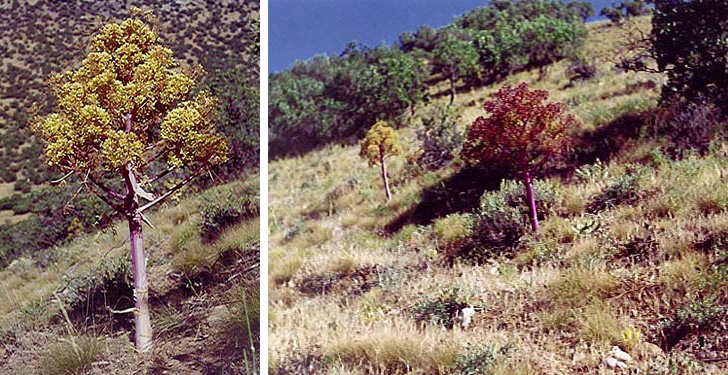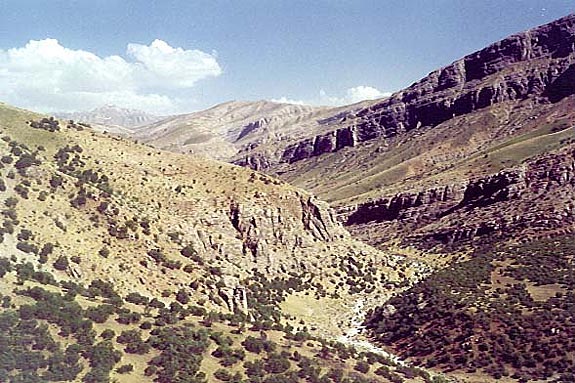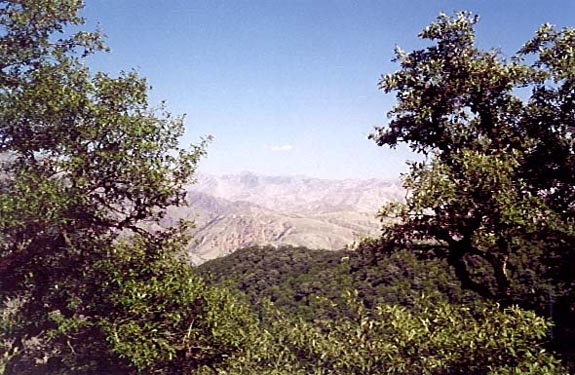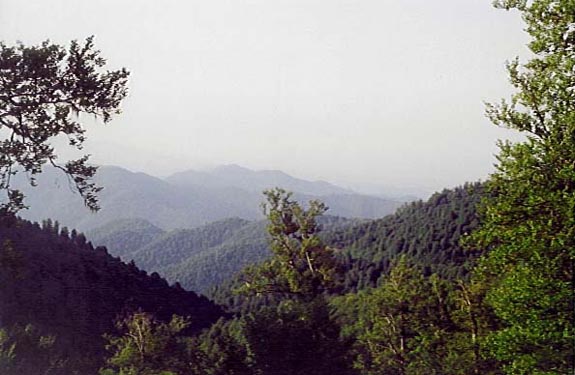[ June 5 - July 5, 2000 ]
Being completely enchanted by Iran and its nature (Figure 1) our group decided to visit the country again. To some extent we visited localities that we already knew from the last expedition and had a closer look at some specific species. Naturally, we also visited a number of places new for us and in this short report I would like to concentrate myself on them.

Figure 1 [Photo © M.Rejzek] Ferula foetida, NW Iran, province Lorestan, Dorud 52km SE Borugerd, 33.25N 49.06E, 1740 m, 13.VI.2000 |
After entering the country in Bazarghan we soon found out that our Nissan equipped with a catalyst will not work as there was no unleaded petrol in the whole of Iran. We did not need more than three days of travelling by local buses with a container and asking many people to find this information. When we were prepared to leave the country and go home for good we just gave try and phoned up the Czech embassy in Tehran to ask about this problem. And indeed, quite soon we had the solution: an additive called CASPIAN. It is not easy to get it in Iran but it works when mixed with normal petrol. And so we could start to search the great country.
Having crossed the NW provinces we arrived in Central Zagros mountains and stopped in a place called Dorud (Figure 2). Knowing this place from the last year we easily found the best localities with quite a rich vegetation and found many interesting species there: Phytoecia (Pygoptosia) eugeniae Ganglbauer, Neoplocaederus scapularis (Fischer von Waldheim), Stictoleptura (Stictoleptura) rufa dimidiata (K.Daniel et J.Daniel), Chlorophorus adelii Holzschuh, etc. We spent another few days in the Central Zagros and then left for the North.

Figure 2 [Photo © M.Rejzek] NW Iran, province Lorestan, Dorud 52km SE Borugerd, 33.25N 49.06E, 1740 m, 13.VI.2000 |
Here, we visited a fantastic locality called Golestan forest (Figures 3 and 4). It is an extensive area covered by a virgin broadleaf forest. The forest covers the N facing slopes of Elborz mountains and certainly belongs to the most valuable places of natural interest in Iran. Golestan forest is a temperate rainforest with chestnut-leaved oak (Quercus castanaefolia), persian ironwood Parrotia persica, hornbeam (Carpinus betulus), Zelkova crenata etc.; frequent are scrub habitats and steppes with Artemisia spp., Astragalus spp., Acantholimon spp. etc., many of them endemic to Iran. From a great number of insect species we collected there I would like to mention: Necydalis (Necydalis) sirexoides Reitter, Isotomus comptus maculicollis Holzschuh, Acanthocinus (Acanthocinus) elegans Ganglbauer, Mesosa (Aplocnemia) obscuricornis Pic, Plagionotus (Plagionotus) arcuatus lugubris (Ménétriés), Plagionotus (Plagionotus) bartholomei (Moltschulsky), Cerambyx (Microcerambyx) multiplicatus Motschulsky, Agapanthia (Epoptes) dahli persica Semenov, Dissopachys pulvinata Reitter, Molorchus (Caenoptera) monticola Plavilstshikov, Pedostrangalia (Pedostrangalia) imperbis (Ménétriés), Anoplistes jomudorum (Plavilstshikov).

Figure 3 [Photo © M.Rejzek] NE Iran, province Khorasan, Golestan forest 45 km NE Minudast, 37.23N 55.47E, 580 m, 16.VI.2000 
Figure 4 [Photo © M.Rejzek] NE Iran, province Khorasan, Golestan forest 60 km NE Minudast, 37.19N 56.01E, 980 m, 19.VI.2000 |
From E Elborz we travelled westwards along the Caspian Sea and stopped in a locality called Calus (Figure 5) in Central Elborz. Here we collected in the forests along a road going to Tehran and we searched a couple of places in different altitudes starting in about 250 metres and ending in a pass in about 2 800 metres above the sea level. Here we met species such as: Anisarthron cyrus (Villiers), Exocentrus pseudopunctipennis Holzschuh, Archandra caspia (Ménétriés), Leptura inermis K.Daniel et J.Daniel, Rhamnusium bicolor lenkoranum Danilevsky, Saperda maculosa Ménétriés, Rhagium pygmaeum Ganglbauer, Mallosia (Submallosia) jakowlewi Semenov, Agapanthia (Epoptes) angelicae Reitter, Xylotrechus sieversi Ganglbauer, and of course many of the species we have already seen in Golestan forest.

Figure 5 [Photo © M.Rejzek] N Iran, province Mazandaran, Calus, 36.34N 51.22E, 250-400 m, 21.-23.VI.2000 |
TThe journey went on westwards until we reached the place were Elborz mountains meets Talesh mountains. Here we stopped in a locality called Rudbar. Besides many species I have already mentioned in this locality we saw: Alosterna (Alosterna) scapularis (Heyden), Anaglyptus (Anaglyptus) ganglbaueri Reitter and Paraclytus raddei (Ganglbauer). After entering the Talesh mountains we reached Asalem forest (Figures 6 and 7), an extensive area of a virgin forest, and started to search the growths along a deep river valley. This locality undoubtedly belongs to the nicest places in N Iran. In addition to the species present in all of N Iran, here we recorded: Leiopus (Leiopus) kharazii Holzschuh, and Stenocorus insitivus (Germar).

Figure 6 [Photo © M.Rejzek] N Iran, prov. Gilan, Asalem 67 km NW Bandar-e Anzali 37.41N 48.50E, 283 m, 29.-30.VI.2000 |

Figure 7 [Photo © M.Rejzek] N Iran, province Gilan, Asalem (pass), 37.37N 48.48E, 1630 m, 29.-30.VI.2000 |
